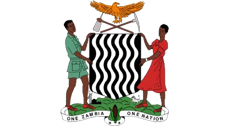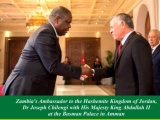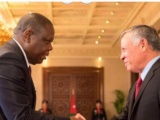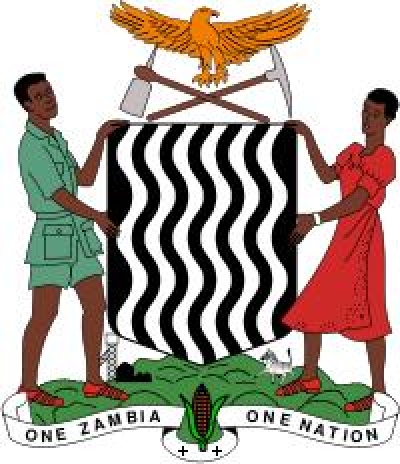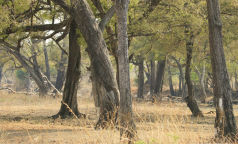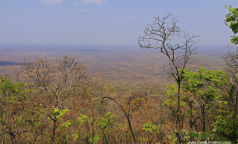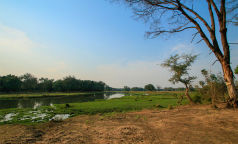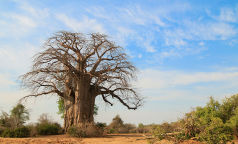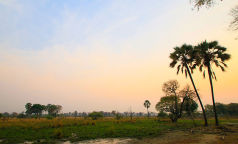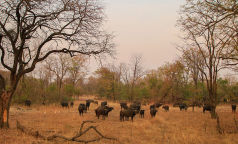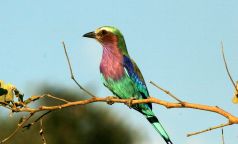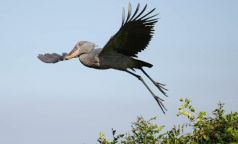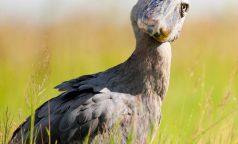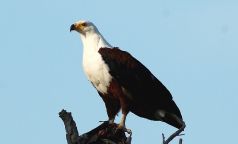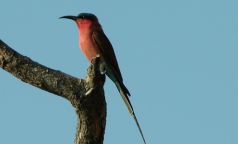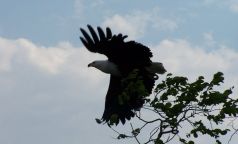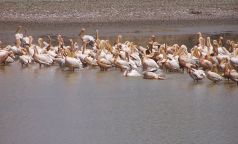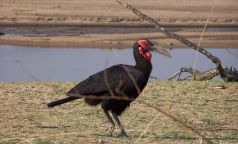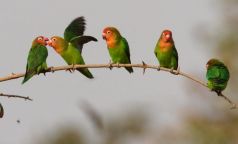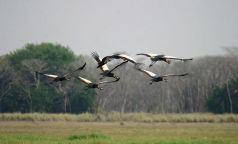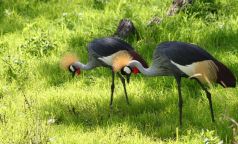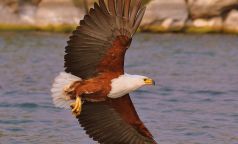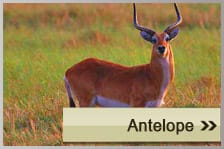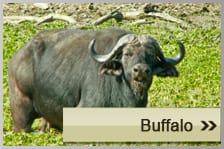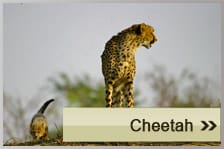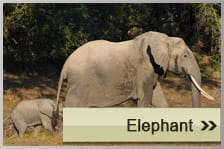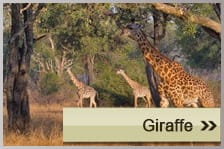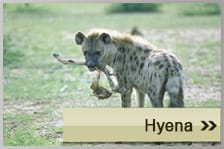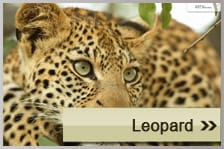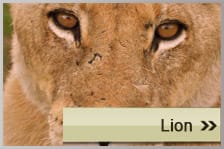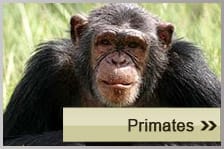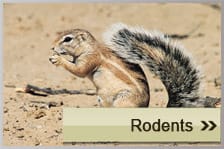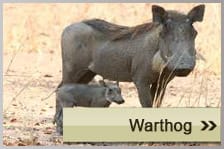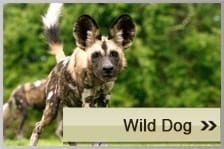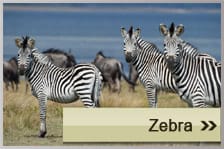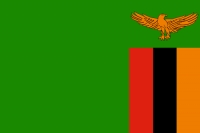Zambia
The Flag of Zambia
Wednesday, 27 May 2015 11:57 Written by Super UserThe flag of Zambia, hoisted for the first time at midnight, October 24, 1964, symbolizes patriotism and the nation’s wealth. Its basic colour is green with an orange-coloured eagle in flight over a rectangular block of three vertical stripes in red, black, and orange (left to right).
Red represents the struggle for freedom; black, the people of Zambia; orange, the country’s mineral wealth; and green, the natural resources. The eagle in flight symbolizes the freedom in Zambia and the ability to rise above the country’s problems.

Government
Wednesday, 27 May 2015 11:56 Written by Super UserZambia is a unitary republican state with the Executive, Legislature and the Judiciary operating as autonomous organs of Government. The Executive is the Republican President who is deputized by a Republican Vice President. The current Republican President is Mr. Michael Chilufya Sata.
Directory of Zambian Government Ministries
Ministry of Agriculture and Livestock
P.O Box RW 50291, Lusaka, Zambia
Tel: +260 211 252552
Ministry of Commerce, Trade and Industry
P.O Box 31968, Lusaka, Zambia
Tel: +260 211 223617
Ministry of Finance
P.O Box 50062, Lusaka, Zambia
Tel: +260 211 251843
Ministry of Foreign Affairs
P.O Box 50069, Lusaka, Zambia
Tel: +260 211 252666/00 260 1 252718
Ministry of Health
P.O Box 30205, Lusaka, Zambia
Tel: +260 211 252989
Ministry of Information and Broadcasting Services
P.O Box 50200, Lusaka, Zambia
Tel: +260 211 235410
Ministry of Labour and Social Security
P.O Box 32186, Lusaka, Zambia
Tel: +260 211 221432
Ministry of Lands, National Resources and Environmental Protection
P.O Box 30069, Lusaka, Zambia
Tel: +260 211 251927
Ministry of Local Government and Housing
P.O Box 3204, Lusaka, Zambia
Tel: +260 211 250528
Ministry of Mines, Energy and Water Development
P.O Box 31969, Lusaka, Zambia
Tel: +260 211 235327
Ministry of Education, Science, Vocational, Training and Early Education
P.O Box 50464, Lusaka, Zambia
Tel: +260 211 252411
Ministry of Tourism and Arts
P.O Box 30055, Lusaka, Zambia
Tel: +260 211 223930
Ministry of Transport, Works, Supply and Communication
P.O Box 50065, Lusaka, Zambia
Tel: +260 211 254158
Ministry of Justice
P.O Box 50106
Lusaka, Zambia
Tel. +260 211252034
Ministry of Gender and Child Development
Lusaka, Zambia
Tel. +260211253513
Ministry of Youth and Sports
Lusaka, Zambia
Tel. +260 211229348
Ministry of Home Affairs
Lusaka, Zambia
Tel. +260211254336
Ministry of Community Development, Mother and Child Health
P.O.Box 30655, Lusaka, Zambia
Tel. +260211225327
Ministry of Chiefs and Traditional Affairs
Lusaka, Zambia
Tel. +260211254158
Ministry of Defence
P. O. Box 31931, Lusaka, Zambia
Tel. +260211254133
REBUBLIC OF ZAMBIA – GOVERNMENT WEBSITE www.zambia.gov.zm
Great Zambia
Wednesday, 27 May 2015 11:54 Written by Super UserWe love Zambia with its beautiful waterways, wild open spaces, and amazing wildlife populations. Located at the crossroads between Southern Africa and Central/East Africa (just north of Botswana and south of the Congo and Tanzania), Zambia is home to the magnificent Victoria Falls and some of Africa’s best wildlife reserves. Check out this video to see some of our favorite camps and lodges. We love Zambia…wonderfully untamed, yet as you will see, down-right civilized!
Community Projects
Thursday, 16 April 2015 14:03 Written by Super User| Project Luangwa |
| Project Luangwa is a charitable organisation which aims to help the local community in and around South Luangwa improve their economic prospects through developing schools. |
Conservation
Thursday, 16 April 2015 14:02 Written by Super User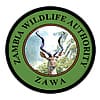 |
Zambia Wildlife Authority |
| The Zambia Wildlife Authority (ZAWA) is mandated under the Zambia Wildlife Act No. 12 of 1998 to manage and conserve Zambia’s wildlife | |
 |
Game Rangers International |
| Game Rangers International is a Zambian conservation NGO established in 2008. It was founded with the specific aim of assisting the wildlife authorities and communities in the Kafue National Park. | |
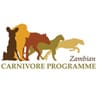 |
Zambian Carnivore Programme |
| The Zambian Carnivore Programme (ZCP) is a non-profit Zambian-registered trust dedicated to conserving large carnivores and the ecosystems in which they reside. | |
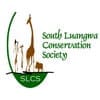 |
South Luangwa Conservation Society |
| The SLCS and ZCP seek to conserve, restore and protect the natural environment in Zambia. Read on to find out what they do and how you can help. | |
 |
Conservation Lake Tanganyika |
| Conservation Lake Tanganyika (CLT) seeks to promote and preserve the biodiversity of Lake Tanganyika for the sustainable benefit for all its inhabitants. | |
 |
Conservation Lower Zambezi |
| Providing a safe refuge for elephants and other wildlife of the Lower Zambezi National Park. | |
 |
Chimfunshi Chimp Sanctuary |
| David and Sheila Siddle’s chimp and wild animal care and reabilitation sanctuary. | |
 |
Chipembele Wildlife Education Trust |
| Chipembele is an international award winning charity working at grass roots level. |
The Zambian People
Thursday, 16 April 2015 14:02 Written by Super Userith a population of less than 15 million, Zambia comprises an amazing 72 ethnic groups, most of which are bantu-speaking. About 90% of the population fall into 9 major ethnolinguistic groups: the Nyanja-Chewa; Bemba; Tonga; Tumbuka; Lunda; Luvale; Kaonde; Nkoya; and Lozi.
Zambia is also home to a thriving Asian community, predominantly of Indian and Chinese origin, numbering around 100,000, as well as a number of European expatriates, some of whom were invited to settle in Zambia by the local government having been cast off their farms in neighbouring Zimbabwe.
All this makes Zambia home to a vibrant mix of cultures, traditions and peoples, and Zambia is also widely-considered to be one of the friendliest and most welcoming nations in the world.
Zambian Culture
Zambia's contemporary culture is a blend of values, norms, material and spiritual traditions of more than 70 ethnically diverse people. Most of the tribes of Zambia moved into the area in a series of migratory waves a few centuries ago. They grew in numbers and many travelled in search of establishing new kingdoms, farming land and pastures.
Before the colonial period, the region now known as Zambia was the home of a number of free states. Each having comprehensive economic links with each other and the outside world along trade routes to the east and west coast of Africa. The main exports were copper, ivory and slaves in exchange for textiles, jewellery, salt and hardware. read more
Zambian Festivals
There are more than 20 annual traditional ceremonies in Zambia, manifesting customs, social life, rituals, oral history, material and spiritual culture. If you have the opportunity to attend one, it is well worthwhile to do so. They provide a valuable insight to a traditional culture that has been passed down from generation to generation.
The decline of traditional customs and culture has been brought about by the infiltration of the west and western ways and the melting pot of various tribes living in the same areas. There has recently been a realisation of the value of traditions and a conscious effort is being made to preserve them. read more
Tribes in Zambia
With over 70 different tribes in Zambia, there is wide cultural diversity. Interestingly enough however, it is one of the few countries in Africa with very little tribal animosity, and the existence of so many tribes has proved less of a political problem than in many other African states. The main tribes are the Lozi, the Bemba, the Ngoni, the Tonga, the Luvale and the Kaonde.
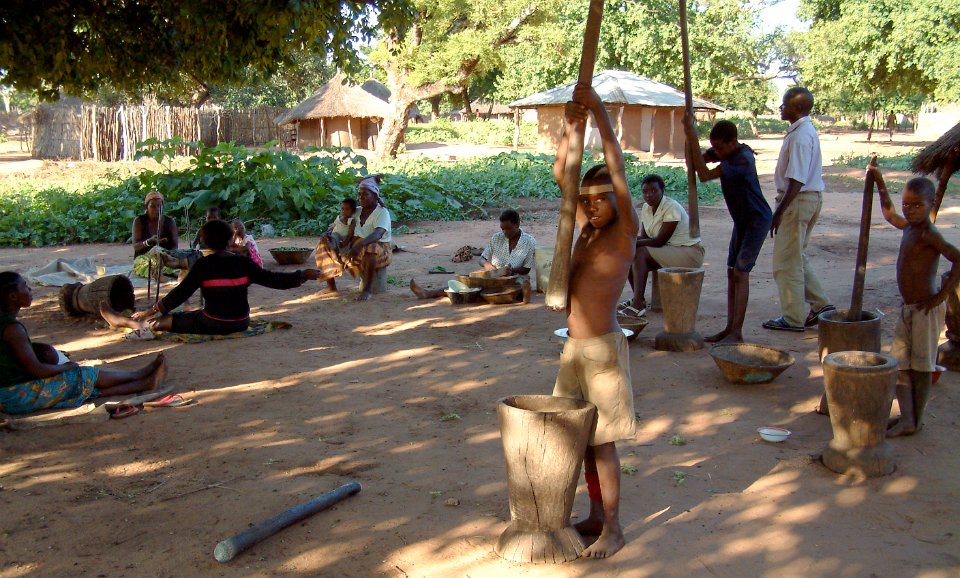
Vegetation
Thursday, 16 April 2015 14:01 Written by Super Userhile it is true that Zambia lacks the spectacular mountains of most of its neighbours, it has more intact miombo woodland than any other country. It also has many large lakes and vast floodplains. The Zambezi and several of its tributaries are larger than any river to the south. There are larger and more spectacular waterfalls in Zambia than in the whole of the rest of the subcontinent, including five major waterfalls on the Kalungwishi River system alone.
Zambia occupies a central position in the Zambesian Region, which is the summer-rainfall belt of southern tropical Africa. Within the region the natural vegetation is largely determined by altitude, rainfall and soils.
Common Names
In countries where the English language has been in use for centuries, such as the United States, South Africa and Australia, many plants are known by common English names. Zambia has a vegetation quite different from those countries and very few species have accepted English names. The tendency to borrow names like “Wild Medlar” is of little help to local Zambians who are never likely to see a medlar, and would not recognize the similarity if they did. Ecologists in this country have preferred to use one of the local names. There is no problem with “mopane” or “baobab”, which are established internationally, but there seems little point in coining a whole new system of names when all plants already have very specific botanical names. It is true that the Latin names can be difficult to get your tongue around, but are essential to be sure of exactly which wild fig, for example, you are looking at. Knowing the botanical name will allow you to find out the local name.
Ecological Zones
Zambia can conveniently be divided into the following ecological zones:
- Plateau – with higher rainfall
- Plateau – with medium rainfall
- Montane
- Kalahari Sand – with higher rainfall
- Kalahari Sand – with medium rainfall
- Valley
Birdlife
Thursday, 16 April 2015 14:01 Written by Super Usery African standards, Zambia is well-known ornithologically. So far 740 species have been recorded here.
Avifaunal Areas of Zambia
To a large extent Zambia’s avifauna is that of the Central African Plateau. The vegetation is principally miombo woodland, bisected by grassy dambos along drainage lines. In some areas the miombo woodland is replaced by other woodland types, dry forest or thicket. Along watercourses there may be riparian forest, or in wetter areas in the north, wet evergreen forest. Most of these habitats have a distinctive set of birds.
Zambia also has low-lying valleys. These include the Luangwa and Middle Zambezi Valleys and the country between Lakes Tanganyika and Mweru. A number of birds found in these areas are different from those occurring at higher altitudes.
A very small part of Zambia has montane altitudes. The avifauna here is quite different from that of the rest of the country and includes several species with very limited ranges.
Codes used are: (E)Endemic (found only in) to this habitat. (m) Established migrant, (n) (s) (e) (w) Found only in northern/southern/eastern/ western Zambia.
Conservation
According to criteria established by Birdlife International, the following birds recorded in Zambia are threatened:
Extinct: none
Threatened: critical: none
Threatened: endangered : White-winged Flufftail (no certain records), Black-cheeked Lovebird
Threatened: vulnerable: Slaty Egret, Cape Vulture (only a migrant to Zambia), Lesser Kestrel, Taita Falcon, Corn Crake, Wattled Crane, White-chested Tinkerbird (may be aberrant Golden-rumped Tinkerbird), Blue Swallow, Papyrus Yellow Warbler
Near-threatened: Madagascar Squacco Heron, Shoebill, Lesser Flamingo, Pallid Harrier, Black-winged Pratincole, Great Snipe, Chaplin’s Barbet, Grimwood’s Longclaw, Churring Cisticola.
The History of Zambia
Thursday, 16 April 2015 13:58 Written by Super Userhe Great Rift Valley, which cleaves the earth from the Lower Zambezi River in Southern Zambia to the headwaters of the Nile in Egypt, is now known to be one of the cradles of the human race, and Zambia's present population lives on lands that have been inhabited by our forebears for uncountable aeons.
Archaeologists have established that in the northern African Rift Valley, the civilizing process got underway at least 3 million years ago, and crude stone implements, similar to some of that age found in Kenya, have also been found beside the Zambezi River.
Early stone age sites have been unearthed in many parts of Zambia, the most significant being at the Kalambo Falls in the North and at Victoria Falls in the south. At the former there is evidence that primitive humans began using fire systematically some 60,000 years ago. At the latter, a complex has been fully exposed showing the development of skills from the most distant past (this 'dig' is enclosed at the Field Museum at the Victoria Falls).
The skull of Broken Hill Man, dated to 70,000 years ago, gives an indication of what humans of that period looked like.
It was during the next phase – the middle Stone Age – with its refinement in the manufacture of tools, differentiation between populations, and burial of the dead, that modern man probably emerged in Zambia, at least 25 000 years ago.
We may imagine family groups of small-statured people living near water and sustaining themselves by hunting the abundant game as well as gathering fruits, tubers and honey from their surroundings (some skulls show serious tooth decay caused by honey?) They would often be on the move, following the antelope as they migrated with the seasons. By 15,000 years ago, the Late Stone Age commenced.
People began to live in caves and rock shelters, the walls of which they decorated with paintings. Very few of these have survived Zambia's seasonally humid climate, and those which have, do not display the sophistication found in the Rock Art found in Zimbabwe or South Africa. But a surviving drawing of an eland at Katolola in the Eastern Province suggests that this art was more than decorative, that it had a ritual or religious meaning: it has been shown in South Africa that this animal was sacred to the Late Stone Age people there.
This spiritual and artistic development occurred alongside another, the invention of the bow and arrow, which revolutionised hunting and also gave humans a mechanical weapon of war, a musical instrument, and a method of starting fire! It has been determined that the people of the Late Stone Age neither tilled the soil nor kept livestock.
New Arrivals
The Zambian Stone Age people probably resembled the present-day San, but towards the end of the period here, there is evidence, from skeletal remains of Negroid physical features, that the hegemony of the aboriginal population was coming to an end. During the centuries between 300 BC and AD 400 Zambia was gradually taken over by Negroid people, who by the later date had occupied the whole country. This was achieved slowly, which allowed the earlier way of life to persist into the present era. read more
The European Factor
The wealth of the Indian Ocean trade was one of the elements (another was to spread Christianity) that in the 15th Century inspired the Portuguese, who had recently reconquered their country from Muslim Moors, to embark on their bold 'Voyages of Discovery'. read more
Invasions from the South
Perhaps as a response to foreign intrusions in southern Africa, Shaka of the Zulu and Nguni clan, set about creating a centralized militaristic state in the early 19th century. Surrounding peoples who did not voluntarily agree to absorption into the growing Zulu empire had no option but to flee for survival. Three of these groups were to make a forceful impact on Zambia, 1500 km to the north of the Zulu heartland in eastern South Africa. read more
Missionaries and Colonisers
In 1840 David Livingstone, a 27 year old Scottish doctor and ordained minister, sailed from Britain to the Cape to work as a medical evangelist with the London Missionary Society. He was to open central Africa to the gaze of British imperialists. Meanwhile, Portugal was planning to consolidate its African territories by uniting Angola and Mozambique across the central plateau. read more
Empire
With considerable help from both Coillard and Dupont, the British imperialist Cecil John Rhodes' British South African Company (BSAC) had been able to take over the whole of Zambia by the end of the 19th century: that Frenchmen should have served the British Empire so well is one of the quirks of history! read more
King Copper
The discovery and opening up during the late 1920s and 1930s of the rich underground ore bodies along the Zambian Copperbelt were soon to make that small region – 120 km long by 40 km wide – one of the worlds' most concentrated and renowned mining areas. read more
Federation
The nationalist movement was given impetus in the early 1950s when the Colonial Office agreed to have Northern Rhodesia joined in a federation with Nyasaland (Malawi), a British 'protectorate', and Southern Rhodesia (Zimbabwe). Southern Rhodesia, under White settler rule, was bankrupt, and saw Northern Rhodesia, with its copper wealth as, to quote one of its political figures, a 'milch cow'.
The Federation was dissolved in 1963, its only enduring monument the Kariba Dam across the Zambezi, intended by the federalists to bind Northern and southern Rhodesia forever. In January the following year Zambia's first universal adult suffrage elections were held and though the ANC performed well in a few substantial areas, UNIP won convincingly, Kaunda becoming Prime Minister. Then at midnight on 24th October 1964, Zambia became an independent republic with him as president.
The one-party state was abolished and free elections were held in October 1991. Kaunda and UNIP were defeated eighty per cent to twenty per cent by the newly formed Movement for Multi-party Democracy, a broad coalition of different interest groups.

